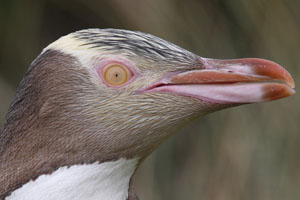
Yellow-Eyed Penguin |
 |
Specific Name: Megadyptes antipodes | ||
|
|
|||
| Adult Height: 65cm | |||
| Adult Weight: 4.5-8kg | |||
| Adult Flipper Length: 20-22cm | |||
| Estimated Population: 7000 |
Feeding: |
||||||
Preferred prey for Yellow-Eyed Penguins are Opalfish, Red and Blue cod, juvenile Arrow Squid, Silverside, Sprat and Ahuru (Van Heezik, 1990. N.Z. J. of Zoology 17, p.201-212). Further studies on stomach samples flushed from birds at the Boulder Beach (Otago) and Long Point (Catlins) colonies between 1991 and 1993 revealed that these species made up about 90% of the consumed biomass and 60% of prey numbers (Moore and Wakelin, 1997. Marine Ornithol. 25, p.17-29). A total of 37 fish species, four cephalopods (predominantly arrow squid) and several crustaceans (e.g. krill) were found. Fish in general accounted for nearly 90% of biomass and 80% of prey numbers. The median number of prey found per stomach flush was 66 although when Krill or small Red Cod were predominantly eaten, there were occasionally over 1000 prey items. Average meal weight was calculated to be around 800 grams. Opalfish (especially H. monopterygius) was by far the most numerous item and accounted for about 30% of the mass of the diet, with Blue Cod and Arrow Squid also accounting for over 10% each. Lengths of the prey eaten were generally below 25 cm, with average lengths of between 5 and 17 cm for the main prey species. The largest prey found was a 50 cm long Lamprey. Most of the fish taken are demersal (bottom-dwelling) species or species that are often found near the sea floor of the continental shelf. In fact Yellow-Eyed Penguins only breed in areas where continental shelf is present. The sea floor may be the source of the small stones that are often found in stomach contents.Individual penguins have been noted to have characteristic diet compositions and this is probably partially linked to their differing foraging range preferences. Detailed analysis of foraging ranges of penguins in the Long Point (Catlins) and Boulder Beach (Otago) areas showed that each penguin had its own preferred area of activity which was often maintained over whole seasons or even years (Moore, 1999. Marine Ornithol. 27, p.49-58). This is also further evidence that the birds are solitary hunters unlike some other penguin species which hunt in groups. Birds were broadly categorized as inshore feeders, midshelf feeders, or outershelf feeders with centers of activities <5, 5-16 or >16 km from the coast, respectively. Median foraging trips were 14 hours, with the median distance from the colony being 13 km (max. 57). Trip lengths tend to increase during the incubation period (21.4 h median, max. 7 days) or in non-breeding birds. In 1992/93, foraging trips were shorter in both time and distance, and this correlated with high breeding success, probably due to ample food supply, especially of Red Cod. Most foraging dives take 2-4 minutes and are to a depth of 30-40 m (Seddon and Van Heezik, 1989. Emu 90, p.53-57) which is close to the sea floor in inshore feeders. Midshelf feeders will tend to be in a water depth of 40-80 m. Birds may dive up to 200 times per day, reaching a maximum depth of about 150 m. Surface speeds during transit to the feeding areas are around 6 km/h.When sea-lions are present near the landing beach, birds may assemble in small groups before dashing towards the shore. Interestingly, Yellow-Eyed Penguins not only have the characteristic white front and dark back, but they also have pink feet with black undersides. A diving penguin is thus entirely dark when viewed from above and entirely light when viewed from underneath. This serves to optimally camouflage the penguin against the dark sea bottom or light sky, respectively, and serves to reduce predation.Chicks are fed at the nest by regurgitation of stomach contents of the returning bird.
|
Reproduction: |
||||||||||||||||||||||
Yellow-Eyed penguins have a long breeding season starting with courtship in August and finally ending with fledging of the chicks the following March.Nest sites are predominantly in densely vegetated coastal areas. Nest bowls are relatively shallow and are lined with twigs and other dry plant material. Protection from sunlight is important to avoid heat stress. Consequently, most nests are found under thick vegetation or in natural hollows. However, penguins may nest successfully on open farmland if predator control measures are in place and at times inexplicably appear to choose relatively open nesting sites (McKay et al., 1999. Marine Ornithol. 27, p.29-35). Nests are usually about 100-200 m from the shore and from 10-30 m apart (Seddon and Davis 1989. Condor 91, p.653-659), although in extreme cases they may lie up to 1 km inland. Since the penguins are good climbers, nests may be found on steep slopes at heights of up to 100 m above sea level. Whilst longer travel distances to the sea require higher energy expenditure, no correlation between nest location and breeding success was reported at Papanui Beach (Brooke Kirkpatrick, Student Symposium 2002, Cornell College). Nest site fidelity is high with only about 2% of breeding birds switching colonies, although the exact location of the nest is subject to more variation.Pairs usually stay together unless one of the partners is lost. Studies conducted from 1991-1996 at Pipikaretu and Ryans Beaches on Otago Peninsula showed annual survival rates of adult birds of 93% for males and 90% for females (Ratz et al., 2004. N.Z. J. Zool. 31, p.133-147). A surplus of male birds is observed at most colonies. Courtship involves various shaking movements, half-trumpeting (head slightly raised, flippers held slightly away from body) and the ecstatic display (head pointing skywards, flippers pointing sideways) which is common to many penguin species.Two eggs are usually laid over a period of 4 days in Sept./Oct. after which both parents alternate in incubation and feeding duties. The eggs are the least dimorphic among penguins and Yellow-Eyed penguins will not sacrifice an egg in times of poor food availability. Yellow-Eyed penguins thus display "brood maximizing" behaviour. This is in stark contrast to "obligate brood reducers" (e.g. Erect-crested, Macaroni) which generally abandon the first egg, or "facultative brood reducers" (e.g. Gentoo, Adelie) that favour the second egg. The reason for these behavioural differences has been attributed to differences in the levels of the hormone prolactin (PRL) at different stages in the breeding cycle (Setiawan et al., 2006. Comp. Biochem. & Physiol. 145(A), p.357-362). Yellow-Eyed penguins continually express high levels of PRL between laying of the 1st and 2nd eggs and this is thought to promote incubation behaviour (as has been demonstrated in other birds). Nevertheless, incubation of the first egg is less intense than incubation after arrival of the second, with the egg(s) being incubated for 80 and 90% of the time, respectively (Seddon, 1988. Ph.D. thesis). Eggs hatch after 39-51 days. The wide range seems to result from the fact that eggs may be left partially uncovered for days to prolong the incubation period. This is common in times of food shortage.Both eggs usually hatch within 24 hours of each other. Hatching success is usually around 85% in undisturbed colonies (Ratz et al., 2004. N.Z. J. Zool. 31, p.133-147). Chicks are brooded for the first 25 days and then attended at the nest for a further 15-25 days before both parents go out to forage. Feeding is performed bill to bill following regurgitation of food by the parent in response to vocal solicitation by the chicks. Both chicks are usually fed at a single session and no significant rivalry is observed between them. The attempt to raise both chicks can take a high toll on the condition of the parental birds in periods of food shortage and may lead to their death or abandonment. In many cases it is thought that one chick could have theoretically survived if treated preferentially. Parents may continue to attend nests with unhatched eggs or dead chicks and the latter are often found flattened as a result. Chicks do not form creches and only fledge in mid-february at an age of about 14 weeks.After chicks have fledged, adult birds feed for about a month to gain weight before returning to their colony to moult. Moulting birds are highly vulnerable and may lose up to half of their body weight in the process. After moulting the birds feed intensively to gain weight again in preparation for the next breeding season.Juveniles moult into adult plumage at one year old, at which point the previously pale head band develops the characteristic yellow colour. Yellow-Eyed penguins reach sexual maturity at an age of 2 years. About half of female birds start breeding at this age with most of the remainder at 3 years, whereas less than 10% of males breed at 2 years, with about half commencing breeding at an age of three and most of the remainder one year later (Richdale 1957. A Population Study of Penguins. Oxford, Clarendon Press). First time breeders tend to have low fertility and sometimes erratic nesting behaviour.
|
General Behaviour: |
||||||||||||||||||||||||
Yellow-Eyed penguins are relatively timid penguins which try to avoid both contact with humans and with other Yellow-Eyed penguins. Birds spend most of their lives near their nesting sites. The exact nest site may vary from year to year, but will tend to be behind the same beach. The area around nests is regarded as a territory during the breeding season and will be defended against other penguins. Non-breeding penguins tend to roost near the sea and may do so in a standing or lying position. During the daytime, penguins may alternate between periods of roosting and preening.Aggression is often expressed by leaning forwards towards the adversary and hunching the shoulders whilst glaring and gaping and making harsh noises. Birds may charge and peck at an opponent but actual contact is rarely made. As with all penguins, actual fighting involves pecking or jabbing with the beak and beating with the leading edge of the flippers. Fighting is rarely observed, probably due to the spacing between nests.In order to avoid conflict, birds may take an appeasement stance which can involve standing tall looking upwards with hunched shoulders when passing other birds. After passing the flippers may be extended forwards and the bird poises shortly before looking over its shoulder. In response to this "salute", the other bird may assume the "Gawky" stance with beak and flippers pointing forward and neck slightly stretched upwards.Preening and other comfort behaviour such as stretching is frequently observed in birds on the way to or from their nesting sites and may be indulged in for protracted periods of time. Yellow-Eyed penguins may allopreen (i.e. preen each other) which serves to remove parasites and reinforce the pair bond. Usually only pairs are observed doing this, occasionally also with their chicks. Allopreening is generally confined to the head and neck regions. These regions can only be preened using the foot or by rubbing against the side of the body in solitary penguins.
Since behaviour is difficult to describe and a full explanation of all aspects is beyond the scope of the present summary, the interested reader is referred to the extremely detailed descriptions of Yellow-Eyed Penguin behaviour that can be found in Seddon et al., 1991 (Marine Ornithol. 19, p.109-115) or in Richdale, 1951 (Sexual behaviour in penguins. Univ. Kansas Press). |
Threats: |
||||||||
The main threats to colonies of Yellow-Eyed penguins are introduced mammalian predators. Stoats, ferrets, cats and dogs may kill birds at individual colonies. Chicks are most vulnerable, whereas adult penguins can usually defend themselves, except against dogs. Probably, no mainland colony could survive without ongoing predator control measures. In fact, penguins nesting on farmland may lose over 90% of their chicks to predation if no protective measures are taken (Marchant and Higgins 1990. Handbook Austral., N.Z., Antarctic Birds, Vol.1, p.236-246). Natural predators at sea include sharks, hookers sea-lions and barracouta.In the 1990s, attempts were made to protect breeding sites from stoats and ferrets by impeding predator movement by a surrounding "grass wall" of rank grass and tussock. However, studies at Boulder Beach (Otago Peninsula) showed that predators preferred the dense grass to open pastures, possibly attracted by the thriving populations of mice found therein (Ratz 2000, N.Z. J Zoology 27, p.57-69). Further, the walkways used by penguins to reach their nests were frequently used by ferrets, thereby possibly channelling them towards the nests where the vulnerable chicks were waiting. Hence, presently, predator trapping or poisoning remain the primary means of control.In recent years, alarmingly high rates of chick mortality have been reported at numerous colonies. Starvation, or infection by bacteria or other parasites seem to be primary causes. Ranum and Wharton (N.Z. J. of Zoology 23, p.83-87 (1996)) reported that 95% of Yellow-Eyed penguins had some nematodes in their guts, however levels were considered low and unlikely to cause health problems. Infectious diseases may cause mortality in a significant proportion of chicks. For example, in Nov. 2004, large numbers of young chicks were lost due to an outbreak of Corynebacterium amycolatum, which caused diphtheria-like lesions (Houston 2005. NZ J. Zool. 32, p.267). Antbiotic treatment yielded mixed results and it seemed that survival depended largely on the mass obtained by the chicks prior to infection. Some bacterial infections may successfully be treated with antibiotics at the few sites where human intervention is possible (R. Goldsworthy, Katiki Penguin Trust, personal comm.). The relatively solitary nesting behaviour of the species should present a greater barrier to parasite-spread than in most other penguins, yet the high mortality may be the result of other factors weakening the penguins resistance to parasites that are usually present at low levels in their bodies, allowing these to grow to life-threatening levels. Insufficient food supply to chicks may be a major factor. Large numbers (at least 130) of adult birds succumbed to an outbreak of avian malaria on Otago Peninsula in 1990 with 30% of the breeding population being lost at Papanui Beach alone (Gill and Darby 1993. N.Z. Vet. J. 41, p.39-42), although outbreaks are fortunately relatively uncommon. Fortunately many of the chicks could be reared in captivity and subsequently released into the wild.Human development is also a major problem as these shy penguins generally require coastal forestation or at least thick bushwork for nesting. Much of this has been cleared during development over the last several hundred years. The penguins nests are usually out of sight of each other so colonies require large spaces to accommodate significant numbers of birds. Further, penguins need the protection of the forest when moulting, since during this period they are land-bound. Cover is important to conceal penguins from predators, but also to provide shade since exposure to direct sunlight for long periods of time may cause heat stress (Seddon and Davis, 1989. Condor 91, p.653-659) which is potentially fatal.Food supply is critical and reproductive success and survival are negatively influenced by reduced food supply during La Nina Southern Oscillation events which raise water temperatures around New Zealand and affect fish numbers (Peacock et al., 2000. N.Z. J. Zool. 27, p.317-325). Indeed historical records as far back as 1938 clearly correlate such events to years with high mortality and reduced breeding success (Moore and Wakelin, 1993. Marine Ornithol. 25, p.17-29). There is further concern that long-term trends of sea temperature changes (e.g. in response to global warming) may cause shifts in fish stocks away from penguin breeding areas. Fisheries are a problem, since they may cause a general decline in fish stocks. During naturally poor fish stock years, fisheries may also cause critical reductions in local fish stocks, although fortunately few sites of intensive fishery overlap with the foraging ranges of Yellow-Eyed Penguins. Penguins may also suffer directly from fishing by becoming caught in fishing nets and drowning. For example, over 40 Yellow-Eyed Penguins deaths could be attributed to drowning after entanglement in gillnets between 1979 and 1997 (Darby and Dawson 2001. NZ J. Zool. 28, p.435 (Abstr.)).Properly controlled tourism does not appear to be a major threat to colonies and may indeed pay for necessary protective measures. Studies at "Penguin Place" at Pipikaretu Beach, Otago Peninsula, showed no significant impact of tourism on breeding success or chick feeding patterns, compared to a nearby control colony (Ratz and Thompson, 1999. Marine Ornithol. 27, p.205.210). However, visitors are largely confined to hides and controlled by trained wardens. In less controlled areas, where visitors may access the landing beaches and sometimes illegally enter nesting areas, a significant negative impact has been documented. McClung et al., 2004 (Biol. Conserv. 119, p.279-285) compared different colonies on Otago Peninsula and found that the mean fledging weight of chicks at Sandfly Bay (frequently visited) was 0.76 kg lower than at the least disturbed study site (Boulder Beach - Highcliff section). There is an established correlation between fledging weight and survival beyond one year. It was suggested that since the penguins will delay landing if visitors are visible on the beach, the meal intended for the chick will be subject to more digestion and will lose nutritional value before it is finally regurgitated at the nest. Further, it is possible that some nest-desertions could be caused by delayed return of the foraging adult. Also, it is conceivable that the risk of predation by sea-lions is increased if penguins have to wait unnecessarily in near-coastal waters before landing. A subsequent study of the Sandfly Bay colony compared to the undisturbed Green Island colony revealed even more worrying results (Ellenberg et al., 2007. Gen. Compar. Endocrinol. 152, p.54-63). The study showed a 50% lower breeding success (i.e. 0.75 v. 1.39 chicks fledged per pair) at Sandfly Bay and again reduced weights (about 0.5 kg lower), especially of double-chick broods, in those birds that did fledge. Interestingly, breeding failure at Sandfly Bay was not caused by predation but was largely due to abandonment of eggs or chicks. When abandoned eggs were opened, all but one was fertile and contained a well-developed embryo. Hence, disturbance of the nest during the incubation phase is a likely major cause of abandonment. Indeed, uneducated visitors have been observed climbing to nests and human footprints have repeatedly been noted near abandoned ones. Ellenberg et al. also studied levels of the stress hormone corticosterone in penguins nesting at Sandfly Bay and Green Island. Whilst basal levels were similar, Sandfly Bay birds showed higher stress-responses when handled (for scientific study). This suggests that whilst birds may become slightly desensitized (habituated) to human presence by repeated low level and predictable visitation, birds at Sandfly Bay may have conversely been sensitized to humans by visitors who run or shout in their vicinity or even chase them. As a result of such experiences these birds may perceive humans as potential predators. Stress may not only cause nest abandonment but also may result in higher energy expenditure (e.g. via an increased heart-rate). Consequently, parental birds may require more energy themselves, thus leaving less food for the chicks.Whatever the exact causes, since Yellow-Eyed Penguins tend to return to the colony where they were born, consistent low survival of birds from a particular colony may eventually lead to its elimination. Only few breeding pairs remained at Sandfly Bay by 2008.The Yellow-Eyed Penguin is struggling to survive on mainland NZ. The Yellow-Eyed Penguin Trust is involved in monitoring and maintaining (predator control, replanting, nest monitoring) a large number of sites on the mainland and Stewart Island. As it does not run a revenue-generating touristic operation, the trust relies largely on donations and a number of dedicated volunteers. Donations may be made online.The mainly government funded Department of Conservation (DOC) is also strongly involved in monitoring and maintaining breeding sites, also on the subantarctic islands. DOC is presently the only NZ-based organisation capable of performing large scale pest eradication programs on off-shore islands, which are often essential for survival or reestablishment of endemic species.
|
Where To See: |
||||||||||||||||||||
The majority of Yellow-Eyed penguins are protected in reserves where introduced predators are kept under control. Although there are still some penguins on mainland NZ outside of these reserves, their numbers are low and visitors should not try to visit these sites as they could disturb these extremely shy birds. The main reserves are on Otago Peninsula. The most visited reserve is probably "Penguin Place". There it is sometimes possible to observe penguins on nests (located in wooden nest boxes) from a system of covered trenches. Whilst artificial nesting boxes are photographically rather unsatisfying, the penguins appear to rather like them and one needs to remember that whilst coastal forests recover it is important to provide a nesting solution for the birds. Also, the nesting boxes can be positioned so that activity on the nest can be viewed easily. Further reserves can be visited and may provide views of birds on natural nests, yet the nests tend to be further away (e.g. Elm Wildlife Tours or Natures Wonders). Touristic development of penguin breeding sites is one of the main ways that funds can be raised for maintaining forestation and controlling predators.North of Dunedin there is a maintained lookout at the Shag Point breeding site. Slightly further north, one finds a very comfortable hide at Katiki Point, from which penguins can be observed landing at a picturesque beach using the binoculars provided. Use of the hide is free although donations are encouraged and go towards maintenance of the site and the adjacent penguin hospital run by the Katiki Point Penguin Trust. The colony is presently the most northerly one of significant size and was established in a "reforested" enclosure by penguins that had been rehabilitated in the hospital many years ago. Please remember that only the ongoing work of the Trust can ensure that the colony continues to thrive.Relatively uncontrolled touristically accessible sites also exist (please see section "threats" which details the downside of visiting such sites). For example, Sandfly Bay on Otago Peninsula has large hides from which penguins can be viewed. Yellow-Eyed penguins can also be viewed from a hide near Nugget Point, South of Dunedin, yet no nests can usually be seen. Early in the morning or shortly before dark are the best times for observation. Please do no follow penguins and keep a low profile and a good distance (100 m on beaches). Nest disturbance is illegal and may cause abandonment, even after you have left, so if you appreciate these birds please keep well away from the nesting areas so that you do not have the chicks on your conscience after leaving. It is noted that all nest photos on this site were taken from public hides or under the supervision of site wardens during scheduled monitoring visits. No flash was used.Probably the largest population of Yellow-Eyed Penguins is found on the Auckland Island Group. Small numbers of supervised visitors have been permitted onto Enderby Island in recent years. NZ-based Heritage Expeditions runs several expedition cruises to the subantarctic islands which include a stop at Enderby.
|
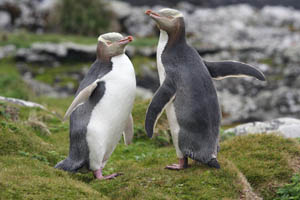 |
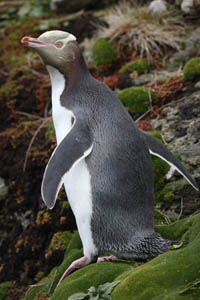 |
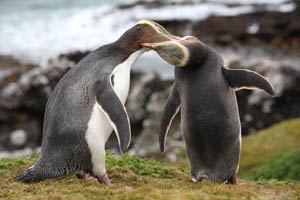 |
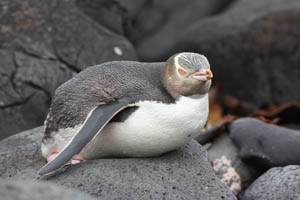 |
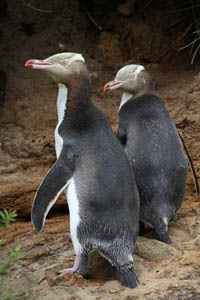 |
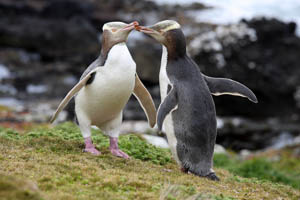 |
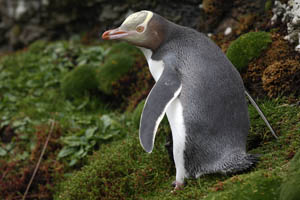 |
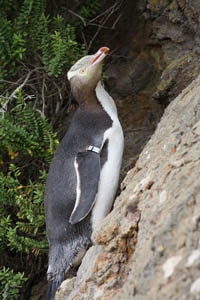 |
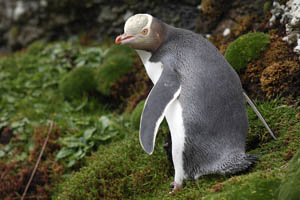 |